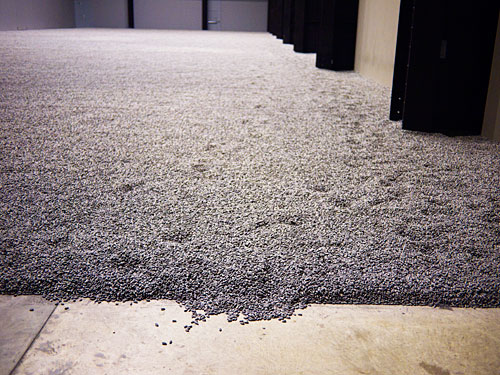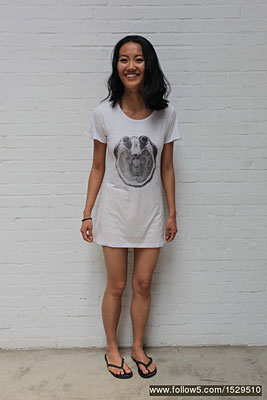
Ai Weiwei. Sunflower Seeds, 2010. Installation view, Turbine Hall, Tate Modern, London. Photo courtesy of Aaron Chen.
An Xiao follows up on yesterday’s post and continues her discussion with Bird’s Nest: Ai Weiwei in English editor Jennifer Ng and translator André Holthe.
An Xiao: Yeah, here in the West, we’re encouraged to brand ourselves and put our names everywhere, but I can certainly see the challenges and why the activity was a powerful one. So what happened after all these individuals participated?
Jennifer Ng: While I cannot prove this, I don’t think anyone was arrested for the activity, at least there were no reports on Twitter about it. In retrospect, the activity really was an interesting social experiment, that when ordinary folks get together to take responsibility and to publicly give out a message, the government really does not have the resources or is simply unable to control the voice of a vast amount of Chinese people that are on the Internet.
Mr. Ai sent them T-shirts and DVDs of his documentaries. It wasn’t just for that one activity however. I think he sends out presents for all of his Twitter projects. Basically he gives them out to whoever requests the DVDs and recently of course the sunflower seeds. For him it’s just an excuse to distribute his work, especially with the t-shirts and the documentaries. I don’t think he needs to do it for fame, but his heart is on giving them out so people can gain exposure to the problems of contemporary Chinese society.
All the documentaries and presents are politically themed. They’re various forms of documentation for the investigations he’s done on problems he’s explored in Chinese society. Giving them out lets more people have access and know about his side of the story in contrast to the official side of the story. They realize the so-called harmonious society is not that harmonious, at least not harmonious in the sense the government wants you to believe.
AX: He gives them out for free?
JN: Yes. Only within China, not sure if shipping is included. 🙂

Ai Weiwei. T-shirt (Brain CT). Photo via the artist.
AX: How about his real world activities? I know recently the art world has been abuzz about his Shanghai studio crab feast.
JN: I’ve noticed that recently his real world activities are increasingly intertwined with his activities online. Take his Turbine Hall installation at the Tate Modern for example, he is giving out his Sunflower Seeds to Chinese Twitterers upon request. And of course, for the Shanghai studio crab feast, he sent out his invitation over Twitter and many of the people who showed up were his followers on Twitter. It’s interesting how he leverages his influence on the Internet to mobilize people in the real world.
Other than that, I feel that he uses his real world activities to put his Twitter statements or his concerns expressed there into action. There are documentaries that were made as results of information he learnt online, such as Twitter users getting beaten up, or the case of Feng Zhenghu, who was stranded in Tokyo’s airport when China refused his entry into Shanghai.
I wonder if his activities set an example for other Chinese Twitterers to put their speech into action. There’s this one layer of followers that’s happy with low involvement. They would just come up with their real names on Twitter. And then there’s the more committed ones. I do find it really interesting that he could mobilize people to take 4–5 hours of a commute to go to Shanghai for the feast and then 4–5 hours to go back.
They are actually an accumulation of followers over different social media networks. Twitter is a recent thing. Before that, there were Chinese microblogging platforms that he has been on. And his blog, which was once very popular and got shut down. Even through those, he accumulates a lot of followers, and now on Twitter he elevates it a little further. Some of these followers have been following him for quite some time. Once he has a call to action, people go ahead and do it. What I want to say is that, the loyalty is one that has been built over time, rather than a mere Twitter fad.
Compared to 1.3 billion, 50,000 is a really small number. Regardless, I think it’s important that there’s someone who’s telling them they’re entitled to their real voice. It’s like a spark for something bigger.
Ai Weiwei / River Crab Feast @ Shanghai Studio via An Xiao on Vimeo
AX: Something I find remarkable about Mr. Ai is that, even though he has 50,000 followers, he’s very accessible. More so than folks who have 10,000 followers. You and I tweet with him quite regularly, and you can see just how active he is based on his @replies and retweets. How does he achieve this?
JN: He would actually try to interact with anyone who’s made a comment directly at him. Some of his responses are really short. It could be as short as being an RT without any kind of actual comment. Sometimes he would just say uh-huh. Even something as simple as a feeling that he did look at the tweet makes a huge difference in presenting who he is. He would respond to people whether it’s a serious question or a silly question, whether it’s a debate or just chatter. He would really spend the time to engage in discussions, and it does not matter whether the other party is a fan or not.
I find that really interesting because you don’t see a lot of artists do that, let alone celebrities. He happens to be both. He engaged with people like a normal person. I think that’s quite rare.
AX: Some of my non-Chinese speaking friends have asked me why he seems to tweet a few things repeatedly, such as his documentation of “So Sorry”. Even if you don’t speak Chinese, it’s very obvious that these are just being repeated everyday. Why do you think he does that?
The tweets tend to be documentations of his investigations, and a compilation of discussions or statements that were made during the trials of other activists, and most of these subjects were also turned into his documentaries. Some of these tweets provide links to his interviews or other public appearances. Some of his art work are also presented in these repeated tweets, but generally these are listings for his documentation of social issues.
It’s probably because a lot of people use mobile phones to access Twitter in China, so it has to be posted over and over again for the tweets to be seen.
Now that I’m using Twitter more, it actually makes sense to keep retweeting the whole thing over everyday, regardless of whether your audience uses mobile devices or not, because information gets washed out very quickly on Twitter. If it’s tweeted once, you can’t really guarantee that everyone would have read it, and even if they did, that they will remember it the next day. If you repeat it over and over again at a fixed time every day, people will eventually remember parts, if not all, of it.
Ai Weiwei: Sunflower seeds via the Tate on YouTube
AX: Any final thoughts?
JN: As an editor, my personal goal for the project is really to make it a resource for those who are interested in Mr. Ai’s work and serve as a bridge between the English speakers and Chinese speakers. It is wonderful to see aiwwenglish connecting speakers of different languages to cross paths and interact because of a common interest. The project has also caught the attention of speakers of languages other than Chinese and English, and it led them to want to start translating as well. So far I have seen occasional translations of our tweets into Italian, Spanish, Japanese, and we have received expressions of interest in translating Mr. Ai’s tweets into other languages. This has all been very exciting.
With our resources, we couldn’t handle all of that, but I was really impressed, surprised, pleased with how it’s sort of inspired other people to want to translate him. Of course, Mr. Ai has sort of this quality that makes people want to translate him and his tweets. Further, the issues that he raised in his tweets should not only be the concerns of the Chinese people, but in various angles his stance of universal values is also highly relevant to the Western world. And if we are to think further, if this kind of language barrier breaking is happening all around the world, then speakers of different languages can really understand each other better. It would avoid a lot of unnecessary stereotypes and misunderstandings.
Artist and designer An Xiao looks at the impact of new technologies in our lives as digital meets analog. She photographs, installs, performs and tweets and has shown her work in publications and art spaces internationally, including the Brooklyn Museum, the Pacific Asia Museum, Yale/Haskins Laboratories, The New York Times and Art in America. Recently listed in The Guardian’s “Who’s who” of the Twitter art world, she writes extensively on social media art as a contributing columnist for Art21 and writer for Brooklyn-based Hyperallergic.




Pingback: Art 2.1 | Translating Ai Weiwei: Bringing Chinese Social Media Art to the English Twittersphere, Part 1 | Art21 Blog